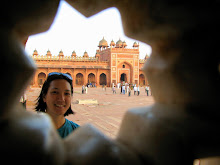In-Service Training, Kitui
December 6, 2005, Tuesday, 9:10pm.
Kitui is different these days. Green. November is the month of the short
rains in Central Kenya, so now everything is sprouting and blooming, and
people have food in their shambas. Even barreling through the countryside
from Nairobi (�Jesus Christ, bwana. Slow down! Slow down!�) I noticed
something was different. The yellow brushy landscape and desperate-looking
white thorn trees have now sprouted a vibrant green fur, and formerly
scorched hillsides of ochre soil are now lined with green terraced crops.
I haven�t been to Nairobi in four months, either. Everytime I got there it
feels like I�ve alighted from a space ship and stepped onto another planet.
People aren�t wearing the exact same Fubu shirts imported from China, and
only a few women wear the traditional African-print dresses with the puffed
sleeves and matching head wraps. No one has holes in their clothes or mud on
their shoes, and the only person who looks dirty is me. I also forget that
Nairobi pickpockets aren�t as incompetent as Kisumu and Eldoret pickpockets,
but this time I�m armed with safety pins (thanks Mom and Dad). Nairobians
are sophisticated, man.
It has also been good to have a week to get together with the rest of my
training group and exchange ideas and feedback on our experiences. In the
last month or so I feel like I�ve lost a little bit of focus on why I�m here
and what role I�m supposed to play in the community; instead I�ve been
getting bitter and cynical about the natural order of things in rural Kenya.
I�m probably the person facing the most blatant cases of corruption in her
community, although maybe other volunteers have just had a better attitude
about it. Anyway it has been good to have my perspective refocused and
realigned. In pre-service training we were introduced to a bunch of tools
for needs assessment and problem solving in our communities, but at the time
they didn�t seem all that valuable, and some of them didn�t really even make
any sense. But being in my village for several months has give these tools a
practical context, and I�m starting to see how I can apply them.
If that woman who came to me a month ago with her sob story asking for a job
came back to me today, I�d whip out a flip chart and marker and map a
problem tree (looks like broccoli but with roots called corruption,
unemployment, drought, etc.) and problem matrix with her. It sounds really
corporate and type-A but I really think that it�s better than shrugging my
shoulders and saying �Pole,� and it helps both Kenyans and me to be albe to
break down the problem visually to understand how they perceive and rank all
the various challenges they face.
But although I�ll go back to my village next week with all these tools and
visions and ideas in my head, I know that I�ll instantly be confronted with
the same conversation stoppers: �Why can�t you get money for us from your
friends and family in America?� This one question has ended conversations
with at least ten groups in my community, and now I have to go back to them
with an open mind, and try to explain that they have resources in their
communities, too, and that the key to improving their lives does not lie
only outside.
-----------
December 10, 2005. Saturday, 10:16. Nairobi.
Just made a list of things I like about Kenya. In our first session of
in-service training last week we were asked to name something we liked about
Kenya and I couldn�t. That�s a sign you�ve become really bummed out about
things.
Today I went to mzungu central in Nairobi, the Java House in city center. I
met two couples in their 20s, typical sophisticated Nairobians. I couldn�t
understand their Kiswahili because they used so much slang, and when I asked
what village they came from they all rolled their eyes the way I do when
people ask me if I�m from China.
�We�re from Nairobi,� they said. �There are people who are born here, you
know.�
Then they proceeded to pour more whiskey into their cappuccinos and laugh
about being alcoholics.


0 Comments:
Post a Comment
<< Home